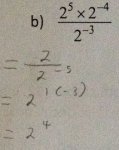For (1) and (3), use exponent rules to simplify and express each of the following as a single expression.
\(\displaystyle \mbox{1-a) }\, 8^5\, \times \,8^8\)
\(\displaystyle \mbox{1-b) }\, \left[4^8\right]^5\)
\(\displaystyle \mbox{1-c) }\, (-4)^8 (-4)^9\)
\(\displaystyle \mbox{1-d) }\, 9^4\, \div\, 9^{-8}\)
\(\displaystyle \mbox{1-e) }\, \left(\frac{1}{4}\right)^3 \, \times \, \left(\frac{1}{4}\right)^2\)
\(\displaystyle \mbox{1-f) }\, 5^{-9}\, \div\, 5^{-8}\)
\(\displaystyle \mbox{1-g) }\, \frac{(-20)^3}{(-20)^6}\)
\(\displaystyle \mbox{1-h) }\, \left[(-2)^7\right]^5\)
\(\displaystyle \mbox{3-a) }\, \frac{6^6\, \times \, 6^{-3}}{6^8\, \times\, 6^{-6}}\)
\(\displaystyle \mbox{3-b) }\, \frac{2^5\, \times\, 2^{-4}}{2^{-3}}\)
\(\displaystyle \mbox{3-c) }\, (6mn^3)(4m^9n^{11})\)
\(\displaystyle \mbox{3-d) }\, \frac{(-4)^9\, \times\, (-4)^5}{\left[(-4)^3\right]^4}\)
5) Recall that the relationship between gravitational acceleration and period for a 1.0-m long pendulum is
T=2πg−21, where
T is the period, in seconds, and
g represents the gravitational acceleration, in meters per second squared (m/s^2).
a) The gravitational acceleration at the surface of Mars is about 3.7 m/s^2. Find the period.
b) The period of a 1.0-m long pendulum on the surface of Venus is approximately 2.1 s. Determine the gravitational acceleration,
g, on the surface of Venus.
6) All living organisms contain both carbon-12, which does not decay, and radioactive carbon-14, which decreases exponentially. The decay process can be modelled using the function
P(t)=100(21)5730t, where
P represents the percent of carbon-14 remaining and
t represents the time, in years. What percentage of the original carbon-14 remains in the fossils after 2500 years?

